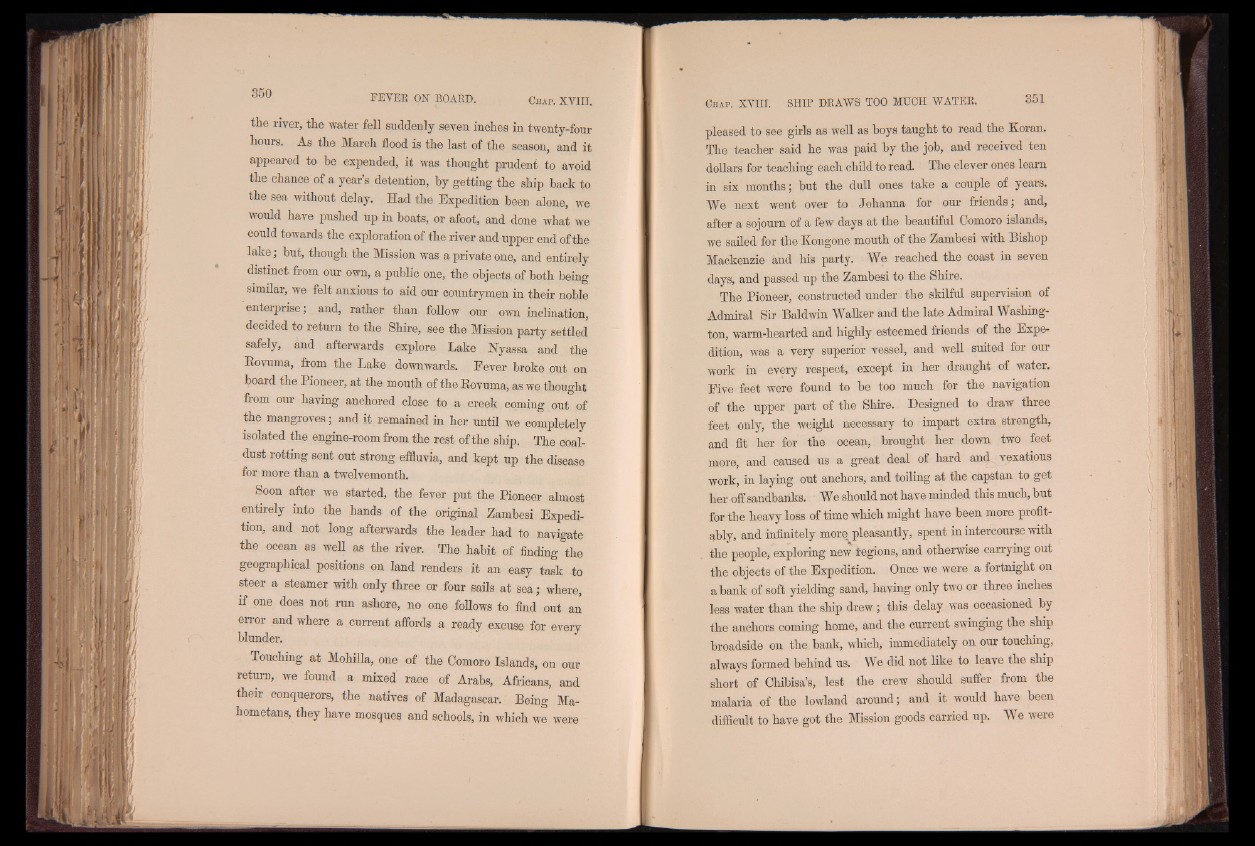
the river, the water fell suddenly seven inches in twenty-four
hours. As the March flood is the last of the season, and it
appeared to be expended, it was thought prudent to avoid
the chance of a year’s detention, by getting the ship back to
the sea without delay. Had the Expedition been alone, we
would have pushed up in boats, or afoot, and done what we
could towards the exploration of the river and upper end of the
lake; but, though the Mission was a private one, and entirely
distinct from our own, a public one, the objects of both being
similar, we felt anxious to aid our countrymen in their noble
enterprise; and, rather than follow our own inclination,
decided to return to the Shire, see the Mission party settled
safely, and afterwards explore Lake Nyassa and the
Kovuma, from the Lake downwards. Fever broke out on
board the Pioneer, at the mouth of the Rovuma, as we thought
from our having anchored close to a creek coming out of
the mangroves; and it remained in her until we completely
isolated the engine-room from the rest of the ship. The coal-
dust rotting sent out strong effluvia, and kept up the disease
for more than a twelvemonth.
Soon after we started, the fever put the Pioneer almost
entirely into the hands of the original Zambesi Expedition,
and not long afterwards the leader had to navigate
the ocean as well as the river. The habit of finding the
geographical positions on land renders it an easy task to
rteer a steamer with only three or four sails at sea; where,
if one does not run ashore, no one follows to find out an
error and where a current affords a ready excuse for every
blunder.
Touching at Mohilla, one of the Comoro Islands, on our
return, we found a mixed race of Arabs, Africans, and
their conquerors, the natives of Madagascar. Being Mahometans,
they have mosques and schools, in which we were
pleased to see girls as well as boys taught to read the Koran.
The teacher said he was paid by the job, and received ten
dollars for teaching each child to read. The clever ones learn
in six months; but the dull ones take a couple of years.
We next went over to Johanna for our friends; and,
after a sojourn of a few days at the beautiful Comoro islands,
we sailed for the Kongone mouth of the Zambesi with Bishop
Mackenzie and his party. We reached the coast in seven
days, and passed up the Zambesi to the Shire.
The Pioneer, constructed under the skilful supervision of
Admiral Sir Baldwin Walker and the late Admiral Washington,
warm-hearted and highly esteemed friends of the Expedition,
was a very superior vessel, and well suited for our
work in every respect, except in her draught of water.
Five feet were found to be too much for the navigation
of the upper part of the Shire. Designed to draw three
feet only, the weight necessary to impart extra strength,
and fit her for the ocean, brought her down two feet
more, and caused us a great deal of hard and vexatious
work, in laying out anchors, and toiling at the capstan to get
her off sandbanks. We should not have minded this much, but
for the heavy loss of time which might have been more profitably,
and infinitely more pleasantly, spent in intercourse with
the people* exploring new legions, and otherwise carrying out
the objects of the Expedition. Once we were a fortnight on
a bank of soft yielding sand, having only two or three inches
less water than the ship drew ; this delay was occasioned by
the anchors coming home, and the current swinging the ship
broadside on the bank, which, immediately on our touching,
always formed behind us. We did not like to leave the ship
short of Chibisa’s, lest the crew should suffer from the
malaria of the lowland around; and it would have been
difficult to have got the Mission goods carried up. We were